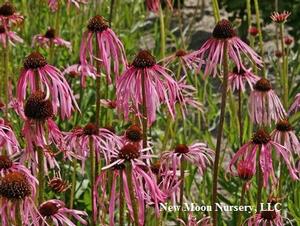Printed at http://www.newmoonnursery.com/index.cfm/
Echinacea pallida
Pale Purple Coneflower
Native to North America
FIRST IMPRESSIONS: Echinacea pallida is a sturdy unbranched perennial with slender lance-shaped leaves. In summer plants are crowned by lovely daisy-like flowers with bold reddish central cones and slender drooping pale violet rays. This low maintenance resilient species thrives in sunny average to dry sites.
HABITAT & HARDINESS: The greatest distribution of Echinacea pallida is in the central United States from Wisconsin and Michigan south to Texas and Louisiana. The species also occurs in Ontario and is scattered in a few eastern states between Maine and Georgia.
Habitats include mesic to dry Blackland prairies, open dry rocky woods, limestone glades, oak savannas, pinelands, old fields and railroad right-of-ways.
Plants are hardy from USDA Zones 3-8.
PLANT DESCRIPTION: Echinacea pallida is an upright unbranched perennial that originates from a stout taproot.
Stems are sturdy and grayish or reddish green. Most leaves are basal but a few are arranged alternately on the lower third of the stem.
Leaves are narrowly lanceolate with almost parallel veins. They are up to 9” long and about 2” wide with smooth margins. The leaf surface is a dull olive green. Leaves and stems are usually covered with fine white hairs.
In early summer solitary 3” daisy-like flowers develop at the stem tip. Each head has a prominent spiny reddish brown cone full of small disc florets. A ring of 12-20 slender drooping ray florets circles the cone. The rays are pale violet, lavender, rose colored or almost white.
After blooming, the rays shrivel and a dark prickly cone full of angular gray nutlets is retained until autumn.
Plants grow 2-3’ tall with 1’ spread.
CULTURAL & MAINTENANCE NEEDS: The ideal site for Echinacea pallida has full sun and fertile well drained soil. Plants tolerate part sun but are less floriferous.
Established plants endure heat, humidity, drought and prescribed burns. They also adapt to alkaline, infertile, clay, shallow rocky or gravelly soils.
Plants are pest resistant and unpalatable to deer and other herbivores.
Deadheading can extend the season of bloom but will remove the desirable seed.
LANDSCAPE USES: This is a good choice for a Wildlife Garden, Cut Flower Garden, Prairie or Meadow. Plants are also used as Butterfly Nectar Plants, Butterfly Host Plants or as part of a Grouping or Mass Planting. Echinacea pallida has Showy Blooms and is appropriate for Cottage Gardens, Deer Resistant Plantings, Water-wise Landscapes, Low Maintenance Plantings, Perennial Borders, Roadsides and bright edges of Shade Gardens.
COMPANION & UNDERSTUDY PLANTS: Try pairing Echinacea pallida with Allium cernuum, Asclepias syriaca, Bouteloua curtipendula, Coreopsis major, Eryngium yuccifolium, Rudbeckia hirta, Monarda fistulosa, Liatris spicata, Schizachyrium scoparium, Andropogon gerardii, Panicum virgatum and Zizia aptera.
Echinacea purpurea has similar appearance and cultural needs and can be substituted in some situations.
TRIVIA: Native bees, butterflies, skippers and the occasional hummingbird seek the nectar. Caterpillars of the Silvery Checkerspot butterfly and several moths feed on the foliage. Eastern Goldfinches consume the nutlike seed. Livestock occasionally nibbles the foliage but this coneflower is not a preferred food source for mammalian herbivores.
Echinacea pallida blooms up to a month earlier than E. purpurea. The leaves and rays of E. pallida are longer and narrower and leaves occur only near the plant’s base.
Height:
2-3 ftSpread:
1 ftSpacing:
2 ftUSDA Hardiness Zone:
3 - 8Bloom Color:
Lavender-PinkEchinacea pallida Characteristics
Attracts Wildlife
- Butterflies
- Songbirds
- Pollinators
Attributes
- Drought Tolerant
- Rock Garden
- Dried Flower
- Reblooming
- Cut Flower
- Naturalizing
- Clay Soil
- Long Blooming
- Fragrant
- East-Coast Native
Exposure
- Full Sun to Partial Shade
Deer Resistant
- Deer Resistant
Flowering Months
- June
- September
- August
- July
Foliage Color
- Green
Growth Rate
- Fast
Salt Tolerance
- Low
Season of Interest (Foliage)
- Summer
Soil Moisture Preference
- Dry to Moist

